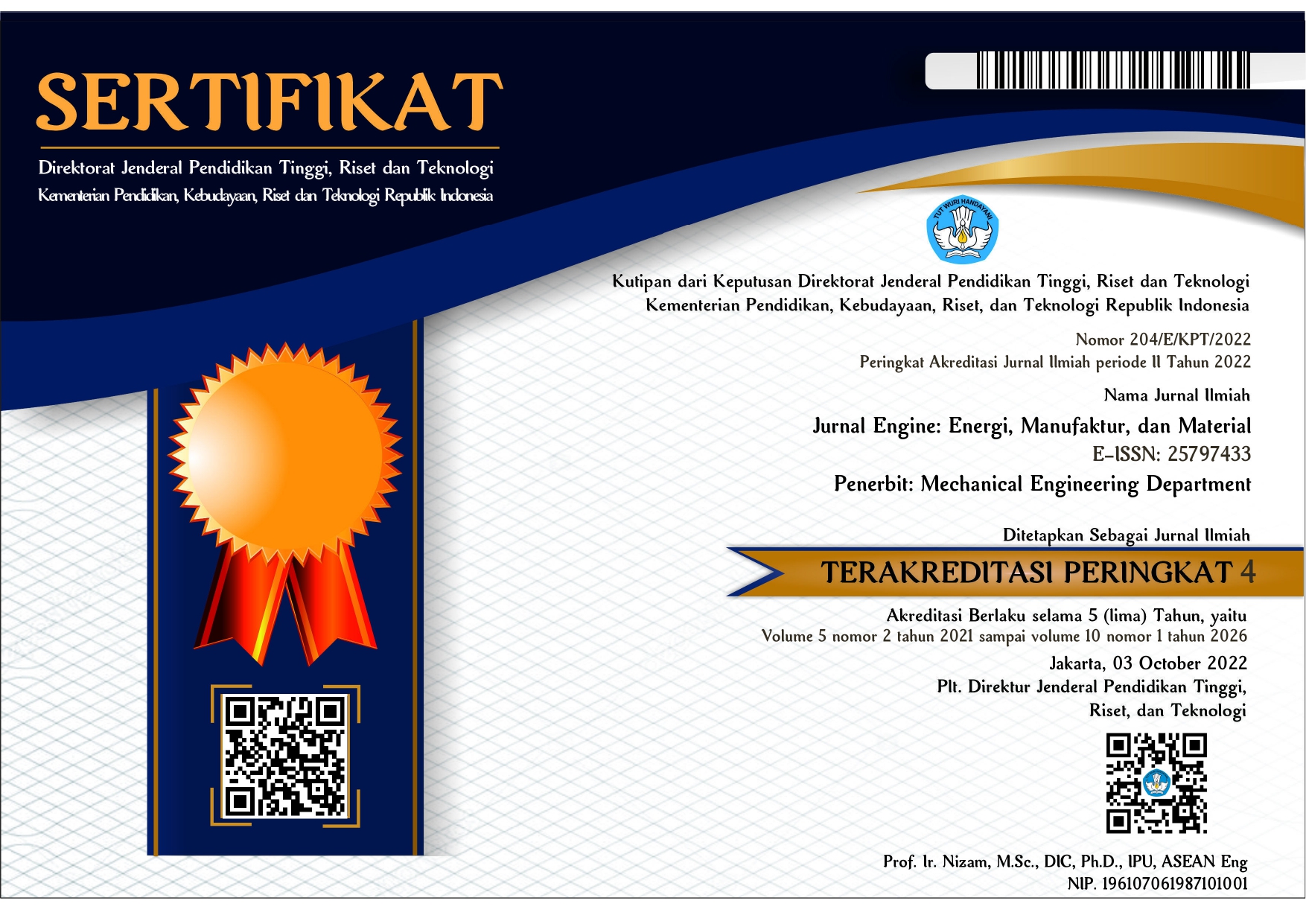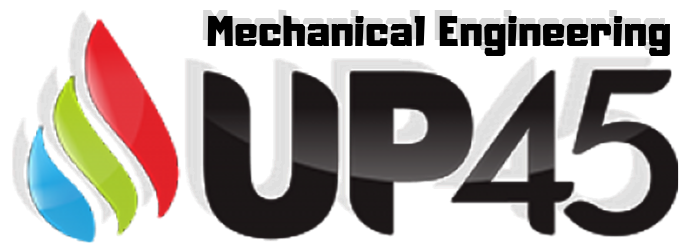Energi Listrik pada Industri Kecil Teh Celup Herbal Daun Urokep
DOI:
https://doi.org/10.30588/jeemm.v6i1.905Keywords:
Urokep Leaf, Energy, Chopping Dried Leaf, Pressing TeabagsAbstract
Urokep leaf or Chinese Ketepeng (Senna alata) is one of the most commonly found medicinal plants and can be used as raw material for herbal tea bags. An essential process in making herbal tea on a household scale is the chopping of dried leaves into a powder that is ready to be put into teabags and pressing the teabags. The leaf shredder process can use a chopper and a blender, while the teabag pressing process uses an impulse sealer. This study aims to compare the energy needed by choppers and blenders in making urokep leaf teabag powder, as well as the use of impulse sealers with element lengths of 20 cm and 30 cm. The research was divided into two stages, i.e. chopping the dried leaves into the powder stage and pressing the teabags stage. The chopping dry leaf into the powder stage was counted by calculating the time for the chopper and blender to powder 1 kg of dry leaves. The pressing of the teabags was carried out by calculating the pressing time of 1000 teabags using an impulse sealer with 20 cm and 30 cm element length. The amount of electrical energy is used by multiplying the electric power by the time of each tool.The results showed that the electrical energy used by the chopper to shredder 1 kg of dry Urokep leaves was 0.10833 KwH, while the blender required more energy, which was 0.27833 KwH. The electrical energy to press 1000 teabags used by the impulse sealer 20 cm is lower at 0.310 KwH than the impulse sealer 30 cm 0.633 KwH. The combination of a chopper and impulse sealer 20 cm is highly recommended for household-scale industries.
References
Adelowo, F. (2017). An Overview of the Phytochemical Analysis of Bioactive Compounds in <i>Senna alata</i> Advances in Biochemistry, 5(5), 102. https://doi.org/10.11648/j.ab.20170505.14
Aderemi, A. O., Ilori, M. O., Aderemi, H. O., & Akinbami, J. F. K. (2009). Assessment of electrical energy use efficiency in Nigeria food industry. African Journal of Food Science, 3(8), 206–216. http://www.academicjournals.org/ajfs
Bassi, P., Kumar, V., Kumar, S., Kaur, S., Gat, Y., & Majid, I. (2020). Importance and prior considerations for development and utilization of tea bags: A critical review. Journal of Food Process Engineering, 43(1), 1–10. https://doi.org/10.1111/jfpe.13069
Christelle Nadia, N. A. (2014). In Vitro Sensitivity of Plasmodium falciparum Field Isolates to Methanolic and Aqueous Extracts of Cassia alata (Fabaceae). Alternative & Integrative Medicine, 03(02), 2–5. https://doi.org/10.4172/2327-5162.1000159
Das, M., & Chowdhury, T. (2016). Heat sealing property of starch based self-supporting edible films. Food Packaging and Shelf Life, 9, 64–68. https://doi.org/10.1016/j.fpsl.2016.05.002
Fernandes, A., Maharani, R., Wahyudianto, A. (2020). Uji Fitokimia Dan Gc-Ms Daun Urokep (Senna Alata) Sebagai Bahan Obat Pelangsing Tradisional Asal Nyapa Indah, Berau. SCIENTIA : Jurnal Farmasi Dan Kesehatan, 10(1), 48. https://doi.org/10.36434/scientia.v10i1.246
Fernando, Y. C., & Noya, S. (2014). Optimasi Lini Produksi Dengan Value Stream Mapping Dan Value Stream Analysis Tools. Jurnal Ilmiah Teknik Industri, 13(2), 125–133.
Gaddam, S. A., Kotakadi, V. S., Sai Gopal, D. V. R., Subba Rao, Y., & Varada Reddy, A. (2014). Efficient and robust biofabrication of silver nanoparticles by cassia alata leaf extract and their antimicrobial activity. Journal of Nanostructure in Chemistry, 4(1). https://doi.org/10.1007/s40097-014-0082-5
Gritsanapan, W., & Magneesri, P. (2009). Standardized Senna alata leaf extract. Journal of Health Research, 23(2), 59–64. www.thaiscience.info/journals/Article/JHRE/10893386.pdf
Hamarung, M. A., & Jasman, J. (2019). Pengaruh Kemiringan dan Jumlah Pisau Pencacah terhadap Kinerja Mesin Pencacah Rumput untuk Kompos. Energi, Manufaktur, Dan Material, 3(2), 53–59.
Juli Setiawan. (2019). Analisa pengaruh jumlah pisau potong terhadap produktifitas mesin pencacah rumput gajah. Sekripsi, 1–51.
Kumarihami, H. M. P. C., & Song, K. J. (2018). Review on Challenges and Opportunities in Global Tea Industry. The Korean Tea Society, 24(3), 79–87. https://doi.org/10.29225/jkts.2018.24.3.79
Lam, S. S., Liew, R. K., Wong, Y. M., Yek, P. N. Y., Ma, N. L., Lee, C. L., & Chase, H. A. (2017). Microwave-assisted pyrolysis with chemical activation, an innovative method to convert orange peel into activated carbon with improved properties as dye adsorbent. Journal of Cleaner Production, 162, 1376–1387. https://doi.org/10.1016/j.jclepro.2017.06.131
Lam, S. S., Wan Mahari, W. A., Cheng, C. K., Omar, R., Chong, C. T., & Chase, H. A. (2016). Recovery of diesel-like fuel from waste palm oil by pyrolysis using a microwave heated bed of activated carbon. Energy, 115, 791–799. https://doi.org/10.1016/j.energy.2016.09.076
Lukma, H. N. & A. B. (2018). PERANCANGAN PEMANAS AIR OHMIK SEDERHANA BERBAHAN DASAR SENDOK MAKAN LOGAM. Qua Teknika, 8(1), 22–31. http://journals.sagepub.com/doi/10.1177/1120700020921110%0Ahttps://doi.org/10.1016/j.reuma.2018.06.001%0Ahttps://doi.org/10.1016/j.arth.2018.03.044%0Ahttps://reader.elsevier.com/reader/sd/pii/S1063458420300078?token=C039B8B13922A2079230DC9AF11A333E295FCD8
Marczuk, A., Caban, J., Aleshkin, A. V., Savinykh, P. A., Isupov, A. Y., & Ivanov, I. I. (2019). Modeling and simulation of particle motion in the operation area of a centrifugal rotary chopper machine. Sustainability (Switzerland), 11(18). https://doi.org/10.3390/su11184873
Naowaboot, J., & Piyabhan, P. (2017). Senna alata leaf extract restores insulin sensitivity in high-fat diet-induced obese mice. Clinical Phytoscience, 2(1). https://doi.org/10.1186/s40816-016-0032-5
Naowaboot, J., Somparn, N., Saentaweesuk, S., & Pannangpetch, P. (2015). Umbelliferone Improves an Impaired Glucose and Lipid Metabolism in High-Fat Diet/Streptozotocin-Induced Type 2 Diabetic Rats. Phytotherapy Research, 29(9), 1388–1395. https://doi.org/10.1002/ptr.5392
Naowaboot, J., & Wannasiri, S. (2016). Anti-lipogenic effect of Senna alata leaf extract in high-fat diet-induced obese mice. Asian Pacific Journal of Tropical Biomedicine, 6(3), 232–238. https://doi.org/10.1016/j.apjtb.2015.12.006
Nooyo, I. (2019). Analisis Usaha Industri Rumah Tangga Minyak Kelapa Tradisional Di Kecamatan Patilnggio Kabupaten Pohuwato. 17, 1–10.
Oladeji, O. S., Adelowo, F. E., Oluyori, A. P., & Bankole, D. T. (2020). Ethnobotanical Description and Biological Activities of Senna alata. Evidence-Based Complementary and Alternative Medicine, 2020. https://doi.org/10.1155/2020/2580259
Rivai, H., Rina, W., Rina, D. Y., Ramdani, Fatimah, S., Asiska, P. D., & Akmal, D. (2015). Preparation and evaluation of herbal tea and toothpaste of mulberry leaves (Morus alba L.). Research Journal of Pharmaceutical, Biological and Chemical Sciences, 6(4), 1672–1677.
Rooney, C. M., Griffiths, I. M., Brunner, C., Potter, J., Wood-Lee, M., & Please, C. P. (2018). Dynamics of particle chopping in blenders and food processors. Journal of Engineering Mathematics, 112(1), 119–135. https://doi.org/10.1007/s10665-018-9968-4
Sugiarto, Rangga Arie., Ilham, M .Muslimin., Fauzi, A. . S. (2020). Analisa Sudut dan Jumlah Mata Pisau Pada Alat Pencacah Daun Kering Terhadap Hasil Cacahan. 237–240.
Wahid, A., Junaidi, & Arsyad, I. (2014). Analisis Kapasitas dan Kebutuhan Daya Listrik untuk Menghemat Penggunaan Energi Listrik di Fakultas Teknik Universitas Tanjungpura. Jurnal Teknik Elektro Universitas Tanjungpura, Vol.2 No.1.
Yamada, K., Miyata, K., Konishi, R., Tsujii, T., & Hashimoto, Y. (2015). Heat seal procebing by using various seal bar shape. AIP Conference Proceedings, 1664(May 2015), 1–6. https://doi.org/10.1063/1.4918458
Yulina, I. K. (2017). Back to Nature: Kemajuan atau Kemunduran. Mangifera Edu, 2(1), 20–31. https://doi.org/10.31943/mangiferaedu.v2i1.15
Downloads
Published
How to Cite
Issue
Section
License
Authors who publish with Jurnal Engine: Energi, Manufaktur, dan Material agree to the following terms:
Authors retain copyright and grant the Jurnal Engine: Energi, Manufaktur, dan Material right of first publication with the work simultaneously licensed under a Creative Commons Attribution 4.0 International License that allows others to share (copy and redistribute the material in any medium or format) and adapt (remix, transform, and build upon the material) the work for any purpose, even commercially with an acknowledgment of the work's authorship and initial publication in Jurnal Engine: Energi, Manufaktur, dan Material. Authors are able to enter into separate, additional contractual arrangements for the non-exclusive distribution of the journal's published version of the work (e.g., post it to an institutional repository or publish it in a book), with an acknowledgment of its initial publication in Jurnal Engine: Energi, Manufaktur, dan Material. Authors are permitted and encouraged to post their work online (e.g., in institutional repositories or on their website) prior to and during the submission process, as it can lead to productive exchanges, as well as earlier and greater citation of published work (See The Effect of Open Access).


















